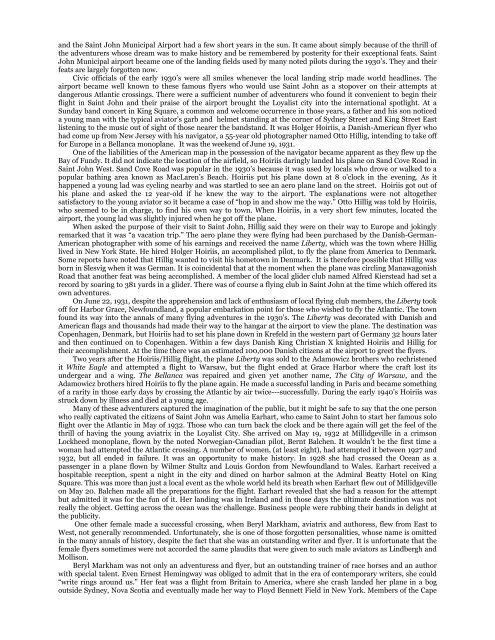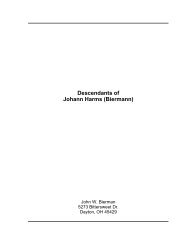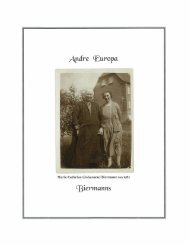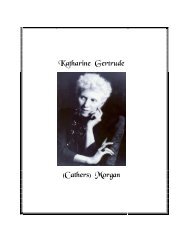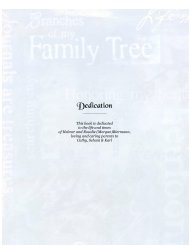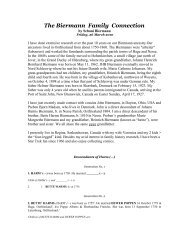A Collection of Dad's Essay's & Writings - Welcome
A Collection of Dad's Essay's & Writings - Welcome
A Collection of Dad's Essay's & Writings - Welcome
You also want an ePaper? Increase the reach of your titles
YUMPU automatically turns print PDFs into web optimized ePapers that Google loves.
and the Saint John Municipal Airport had a few short years in the sun. It came about simply because <strong>of</strong> the thrill <strong>of</strong><br />
the adventurers whose dream was to make history and be remembered by posterity for their exceptional feats. Saint<br />
John Municipal airport became one <strong>of</strong> the landing fields used by many noted pilots during the 1930’s. They and their<br />
feats are largely forgotten now.<br />
Civic <strong>of</strong>ficials <strong>of</strong> the early 1930’s were all smiles whenever the local landing strip made world headlines. The<br />
airport became well known to these famous flyers who would use Saint John as a stopover on their attempts at<br />
dangerous Atlantic crossings. There were a sufficient number <strong>of</strong> adventurers who found it convenient to begin their<br />
flight in Saint John and their praise <strong>of</strong> the airport brought the Loyalist city into the international spotlight. At a<br />
Sunday band concert in King Square, a common and welcome occurrence in those years, a father and his son noticed<br />
a young man with the typical aviator’s garb and helmet standing at the corner <strong>of</strong> Sydney Street and King Street East<br />
listening to the music out <strong>of</strong> sight <strong>of</strong> those nearer the bandstand. It was Holger Hoiriis, a Danish-American flyer who<br />
had come up from New Jersey with his navigator, a 55-year old photographer named Otto Hillig, intending to take <strong>of</strong>f<br />
for Europe in a Bellanca monoplane. It was the weekend <strong>of</strong> June 19, 1931.<br />
One <strong>of</strong> the liabilities <strong>of</strong> the American map in the possession <strong>of</strong> the navigator became apparent as they flew up the<br />
Bay <strong>of</strong> Fundy. It did not indicate the location <strong>of</strong> the airfield, so Hoiriis daringly landed his plane on Sand Cove Road in<br />
Saint John West. Sand Cove Road was popular in the 1930’s because it was used by locals who drove or walked to a<br />
popular bathing area known as MacLaren’s Beach. Hoiriis put his plane down at 8 o’clock in the evening. As it<br />
happened a young lad was cycling nearby and was startled to see an aero plane land on the street. Hoiriis got out <strong>of</strong><br />
his plane and asked the 12 year-old if he knew the way to the airport. The explanations were not altogether<br />
satisfactory to the young aviator so it became a case <strong>of</strong> “hop in and show me the way.” Otto Hillig was told by Hoiriis,<br />
who seemed to be in charge, to find his own way to town. When Hoiriis, in a very short few minutes, located the<br />
airport, the young lad was slightly injured when he got <strong>of</strong>f the plane.<br />
When asked the purpose <strong>of</strong> their visit to Saint John, Hillig said they were on their way to Europe and jokingly<br />
remarked that it was “a vacation trip.” The aero plane they were flying had been purchased by the Danish-German-<br />
American photographer with some <strong>of</strong> his earnings and received the name Liberty, which was the town where Hillig<br />
lived in New York State. He hired Holger Hoiriis, an accomplished pilot, to fly the plane from America to Denmark.<br />
Some reports have noted that Hillig wanted to visit his hometown in Denmark. It is therefore possible that Hillig was<br />
born in Slesvig when it was German. It is coincidental that at the moment when the plane was circling Manawagonish<br />
Road that another feat was being accomplished. A member <strong>of</strong> the local glider club named Alfred Kierstead had set a<br />
record by soaring to 381 yards in a glider. There was <strong>of</strong> course a flying club in Saint John at the time which <strong>of</strong>fered its<br />
own adventures.<br />
On June 22, 1931, despite the apprehension and lack <strong>of</strong> enthusiasm <strong>of</strong> local flying club members, the Liberty took<br />
<strong>of</strong>f for Harbor Grace, Newfoundland, a popular embarkation point for those who wished to fly the Atlantic. The town<br />
found its way into the annals <strong>of</strong> many flying adventures in the 1930’s. The Liberty was decorated with Danish and<br />
American flags and thousands had made their way to the hangar at the airport to view the plane. The destination was<br />
Copenhagen, Denmark, but Hoiriis had to set his plane down in Krefeld in the western part <strong>of</strong> Germany 32 hours later<br />
and then continued on to Copenhagen. Within a few days Danish King Christian X knighted Hoiriis and Hillig for<br />
their accomplishment. At the time there was an estimated 100,000 Danish citizens at the airport to greet the flyers.<br />
Two years after the Hoiriis/Hillig flight, the plane Liberty was sold to the Adamowicz brothers who rechristened<br />
it White Eagle and attempted a flight to Warsaw, but the flight ended at Grace Harbor where the craft lost its<br />
undergear and a wing. The Bellanca was repaired and given yet another name, The City <strong>of</strong> Warsaw, and the<br />
Adamowicz brothers hired Hoiriis to fly the plane again. He made a successful landing in Paris and became something<br />
<strong>of</strong> a rarity in those early days by crossing the Atlantic by air twice---successfully. During the early 1940’s Hoiriis was<br />
struck down by illness and died at a young age.<br />
Many <strong>of</strong> these adventurers captured the imagination <strong>of</strong> the public, but it might be safe to say that the one person<br />
who really captivated the citizens <strong>of</strong> Saint John was Amelia Earhart, who came to Saint John to start her famous solo<br />
flight over the Atlantic in May <strong>of</strong> 1932. Those who can turn back the clock and be there again will get the feel <strong>of</strong> the<br />
thrill <strong>of</strong> having the young aviatrix in the Loyalist City. She arrived on May 19, 1932 at Millidgeville in a crimson<br />
Lockheed monoplane, flown by the noted Norwegian-Canadian pilot, Bernt Balchen. It wouldn’t be the first time a<br />
woman had attempted the Atlantic crossing. A number <strong>of</strong> women, (at least eight), had attempted it between 1927 and<br />
1932, but all ended in failure. It was an opportunity to make history. In 1928 she had crossed the Ocean as a<br />
passenger in a plane flown by Wilmer Stultz and Louis Gordon from Newfoundland to Wales. Earhart received a<br />
hospitable reception, spent a night in the city and dined on harbor salmon at the Admiral Beatty Hotel on King<br />
Square. This was more than just a local event as the whole world held its breath when Earhart flew out <strong>of</strong> Millidgeville<br />
on May 20. Balchen made all the preparations for the flight. Earhart revealed that she had a reason for the attempt<br />
but admitted it was for the fun <strong>of</strong> it. Her landing was in Ireland and in those days the ultimate destination was not<br />
really the object. Getting across the ocean was the challenge. Business people were rubbing their hands in delight at<br />
the publicity.<br />
One other female made a successful crossing, when Beryl Markham, aviatrix and authoress, flew from East to<br />
West, not generally recommended. Unfortunately, she is one <strong>of</strong> those forgotten personalities, whose name is omitted<br />
in the many annals <strong>of</strong> history, despite the fact that she was an outstanding writer and flyer. It is unfortunate that the<br />
female flyers sometimes were not accorded the same plaudits that were given to such male aviators as Lindbergh and<br />
Mollison.<br />
Beryl Markham was not only an adventuress and flyer, but an outstanding trainer <strong>of</strong> race horses and an author<br />
with special talent. Even Ernest Hemingway was obliged to admit that in the era <strong>of</strong> contemporary writers, she could<br />
“write rings around us.” Her feat was a flight from Britain to America, where she crash landed her plane in a bog<br />
outside Sydney, Nova Scotia and eventually made her way to Floyd Bennett Field in New York. Members <strong>of</strong> the Cape


